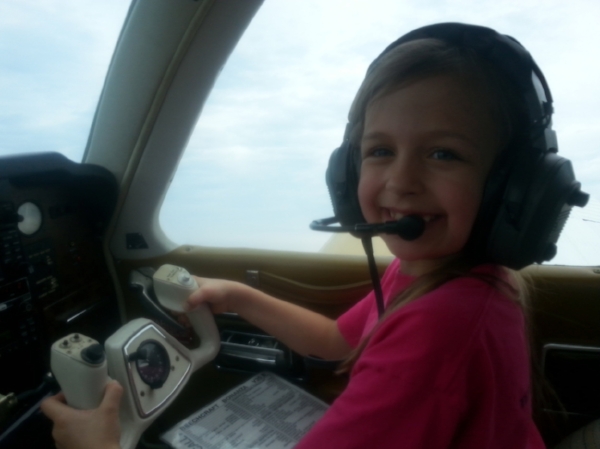Private Pilot Training
Meet Sadie (my daughter) she is 9 years old and a natural.
Private Pilot Training
Have you always dreamed of flying, but just did not know how to get started. Maybe you are not sure if you have the skills. Maybe you are nervous about flying and even that big commercial airliner makes you uneasy.
At BPA we will help you fulfill those dreams, teach you the skills, and get you past those fears that hold many people back from enjoying the thrill of flight.
Your time as a student pilot preparing for your private pilot certificate should be challenging, but the reward is unmatched. You will be introduced to scenarios that require quick decision making and application of several different skills at the same time. The goal is to prepare you with the knowledge and ability to safely fly an aircraft in many different situations. The safer you are and the more confidence (not arrogance!) you have will ensure that even the most difficult situations can be dealt with appropriately and professionally. The challenging training is what makes flying fun. Even after you complete your private pilot training and earn your certificate it is very important to continue learning advanced piloting skills.
I enjoy sharing the experience of flight with people who have never had a chance to fly a plane on their own before. If I am nervous, scared, and unprepared I can almost guarantee my passenger will feel the same way. I want to ensure their first experience is a positive one, and you should do the same when you have an opportunity to share what you have learned with someone else. “Good” pilots knows how to fly. “Great” pilots continuously improve their flying ability by learning new skills and challenging themselves to make every flight better than before. Even on that Sunday afternoon pleasure flight you will find yourself trying to finish off the flight with the best landing you have ever done. And the next Sunday you will try to beat your best again. It is just what “great” pilots do.
As your flight instructor, I will put forth my best effort to teach you and train you as best I know how. I will challenge you during each lesson to improve upon the last one. I will also do my best to keep a smile on your face even when it seems difficult. You will never have the “perfect” flight. I have never had one! It is important to learn from our mistakes and do our best not to repeat them. I will be honest with you when you are struggling and find ways to help you improve. Flying is fun! I intend to keep it that way for you. There is no point on spending your hard earned money on something that you do not enjoy.
At BPA your private pilot training will begin in a classic Cessna 120 “Taildragger” aircraft. We will follow a developed and individually customized training syllabus to ensure that your learning time is maximized and efficient. Starting off in this classic taildragger will greatly improve your basic flying skills and prepare you to fly many different aircraft in the future. You may even get the chance during your private pilot training to fly a few different aircraft to expand your experience.
Big Papa Aviation - Basic Private Pilot Training Information
The FAA mandates that student pilots accomplish a “minimum” amount of flight training before a practical examination (“checkride”) with an examiner. These minimums can be uniquely tailored in a syllabus that most effectively and efficiently provides you with the knowledge and skills to safely act as the pilot in command of an aircraft. In general the following minimums apply:
A student pilot, prior to a applying for a private pilot certificate, must log at least:
40 hours of flight time which includes
-At least 20 hours must be flown with an authorized instructor which includes
-At least 3 hours of “cross country” flight training (flights >50nm straight line distance)
-At least 3 hours under instruction at night (1 flight must be “cross country” >100nm) and your night training will include at least 10 take-offs and landings at night)
-At least 3 hours of instruction flying the aircraft solely on the instruments (ie. not looking outside. You will wear a form of goggles that restrict your view to inside the aircraft)
-At least 10 hours must be flown solo. Yes, you will fly by yourself several times before your checkride! This is a very important part of your flying experience that builds confidence.
-At least 5 of your solo hours must be “cross country,” which means you will fly to locations other than the airport you take-off from. There are certain minimum mileage limitations (ex. >50nm in a straight line from take-off to landing and >150nm total distance flown).
Some of these training requirements can be combined in the same flight. For example a portion of a cross country flight may be flown solely on instruments (the 2 hour flight could not only complete 2 hours of your 3 hours cross country requirement, but also count towards 1 hour of your 3 hours instrument requirement).
Remember the 40 hour requirement is a MINIMUM. Together you and your instructor will make the decision as to when you are fully prepared for your checkride.

